Nitrate Pollution in the Groundwater of Bangladesh: An Emerging Threat
Abstract
1. Introduction
2. Methodology
2.1. Nitrogen Pollution Index (NPI)
2.2. Human Health Risk Assessment (HHRA)
| Parameters | Description | Values | Unit | References | |
|---|---|---|---|---|---|
| Adult | Child | ||||
| CDI | Chronic daily intake of nitrate | mg/kg/day | [26] | ||
| CW | Concentration of groundwater nitrate | mg/L | [26] | ||
| IR | Ingestion rate | 2.2 | 1.0 | L | [27] |
| EF | Exposure frequency | 365 | 365 | Days/year | [28] |
| ED | Exposure duration | 70 | 10 | years | [29] |
| BW | Body weight | 70 | 25 | kg | [29] |
| AT | Average time in days | 25,550 | 3650 | days | [27] |
| DAD | Dermal adsorption dose of nitrate | mg/kg/day | [23] | ||
| Ki | Dermal permeability coefficient | 0.001 | cm/h | [23] | |
| SSA | Skin surface area | 16,600 | 12,000 | cm2 | [30] |
| EV | Bathing frequency | 1 | time/day | [9] | |
| CF | Conversion factor | 0.001 | - | [30] | |
| RfD | Reference dose | 1.6 | mg/kg/day | [31] | |
3. Biogeochemistry of Nitrate in Groundwater
4. Drivers That Affect the Variability of Nitrate in Groundwater
5. Distribution and Magnitude of Nitrate Pollution in Groundwater
Nitrate Pollution Index (NPI)
6. Human Health Risk
7. Potential Health Effects of Groundwater Nitrate
8. Recommendations for Preservance of Groundwater Aquifers
- Sustainable disposal and management of industrial and municipal solid waste in lined landfill sites to avoid nitrate leaching into groundwater aquifers.
- Introducing sustainable sewage system management, especially in urban areas, to manage the sewer properly
- Sustainable agricultural practices like proper application of agrochemicals and manures in the crop field and vegetative land to prevent nitrate leaching in aquifers
- Initiation of a thorough survey and site characterization to establish new well sites
- Adopting artificial recharge methods such as piloting the rainwater harvesting technique
- Establishing buffer zones with high vegetation cover that could prevent flows from crop lands and disposal sites.
- Finally, prioritizing awareness creation for improving sanitation and groundwater quality protection among the people of affected districts.
9. Conclusions
Author Contributions
Funding
Institutional Review Board Statement
Informed Consent Statement
Data Availability Statement
Conflicts of Interest
References
- Kazakis, N.; Voudouris, S.K. Groundwater vulnerability and pollution risk assessment of porous aquifers to nitrate: Modifying the DRASTIC method using quantitative parameters. J. Hydrol. 2015, 525, 13–25. [Google Scholar] [CrossRef]
- Jin, Z.; Zhu, Y.; Li, X.; Dong, Y.; An, Z. Soil N retention and nitrate leaching in three types of dunes in the mu us desert of China. Sci. Rep. 2015, 5, 14222. [Google Scholar] [CrossRef]
- Su, X.; Wang, H.; Zhang, Y. Health risk assessment of nitrate contamination in groundwater: A case study of an agricultural area in Northeast China. Water Res. Man. 2013, 27, 3025–3034. Available online: https://link.springer.com/article/10.1007/s11269-013-0330-3 (accessed on 1 January 2023). [CrossRef]
- Zhang, X.; Davidson, E.A.; Mauzerall, D.L.; Searchinger, T.D.; Dumas, P.; Shen, Y. Managing nitrogen for sustainable development. Nature 2015, 528, 51–59. [Google Scholar] [CrossRef] [PubMed]
- Rahman, M.; Khan, M.R.; Ahmed, K.M.; Zahid, A.; Siddique, M.A.M. An assessment of nitrate concentration in the groundwater of the central coastal region of Bangladesh. J. Noami 2018, 35, 107–116. Available online: https://www.researchgate.net/publication/336265035_An_assessment_of_nitrate_concentration_in_the_groundwater_of_the_central_coastal_region_of_Bangladesh (accessed on 1 January 2023).
- Idriss, I.E.A.; Abdel-Azim, M.; Karar, K.I.; Osman, S.; Idris, A.M. Isotopic and chemical facies for assessing the shallow water table aquifer quality in goly region, White Nile state, Sudan: Focusing on nitrate source apportionment and human health risk. Toxin Rev. 2020, 40, 764–776. [Google Scholar] [CrossRef]
- USEPA (US Environmental Protection Agency). Risk Assessment Guidance for Superfund Volume I: Human Health Evaluation Manual (Part E); United States Environmental Protection Agency: Washington, DC, USA, 2004. [Google Scholar]
- Islam, A.R.M.T.; Pal, S.C.; Chowdhuri, I.; Salam, R.; Islam, M.S.; Rahman, M.M.; Zahid, A.; Idris, A.M. Application of novel framework approach for prediction of nitrate concentration susceptibility in coastal multi-aquifers, Bangladesh. Sci. Total Environ. 2021, 801, 149811. [Google Scholar] [CrossRef]
- Yang, M.; Fei, Y.; Ju, Y.; Ma, Z.; Li, H. Health risk assessment of groundwater pollution: A case study of typical city in North China plain. J. Earth Sci. 2012, 23, 33548. Available online: https://link.springer.com/article/10.1007/s12583-012-0260-7 (accessed on 1 January 2023). [CrossRef]
- Halim, M.A.; Majumder, R.K.; Nessa, S.A.; Oda, K.; Hiroshiro, Y.; Saha, B.B.; Hassain, S.M.; Latif, S.A.; Islam, M.A.; Jinno, K. Groundwater contamination with arsenic in Sherajdikhan, Bangladesh: Geochemical and hydrological implications. Environ. Geol. 2009, 58, 73–84. [Google Scholar] [CrossRef]
- Sarker, M.M.R.; Camp, M.C.; Islam1, M.; Ahmed, N.; Walraevens, K. Hydrochemistry in coastal aquifer of southwest Bangladesh: Origin of salinity. Environ. Earth Sci. 2018, 77, 39. [Google Scholar] [CrossRef]
- Bodrud-Doza, M.; Bhuiyan, M.A.H.; Islam, S.D.U.; Rahman, M.S.; Haque, M.M.; Fatema, K.J.; Ahmed, N.; Rakib, M.A.; Rahman, M.A. Hydrogeochemical investigation of groundwater in Dhaka City of Bangladesh using GIS and multivariate statistical techniques. Ground. Sustain. Dev. 2019, 8, 226–244. [Google Scholar] [CrossRef]
- Kabir, M.M.; Hossain, N.; Islam, A.R.M.T.; Akter, S.; Fatema, K.J.; Hilary, L.N.; Hasanuzzaman, M.; Didar-ul-Alam, M.; Choudhury, T.R. Characterization of groundwater hydrogeochemistry, quality, and associated health hazards to the residents of southwestern Bangladesh. Environ. Sci. Poll. Res. 2021, 28, 68745–68761. [Google Scholar] [CrossRef] [PubMed]
- Islam, M.S.; Mostafa, M.G. Groundwater Status and Challenges in Bangladesh. In Sustainable Agriculture Reviews 52; Lichtfouse, E., Ed.; Sustainable Agriculture Reviews; Springer: Cham, Switzerland, 2021; Volume 52. [Google Scholar] [CrossRef]
- Chen, J.; Qian, H.; Gao, Y.; Wang, H.; Zhang, M. Insights into hydrological and hydrochemical processes in response to water replenishment for lakes in arid regions. J. Hydrol. 2020, 581, 124386. [Google Scholar] [CrossRef]
- Qian, H.; Chen, J.; Howard, K.W. Assessing groundwater pollution and potential remediation processes in a multi-layer aquifer system. Environ. Poll. 2020, 263, 114669. [Google Scholar] [CrossRef]
- Baghapour, M.A.; Nobandegani, A.F.; Talebbeydokhti, N.; Bagherzadeh, S.; Nadiri, A.A.; Gharekhani, M.; Chitsazan, N. Optimization of DRASTIC method by artificial neural network, nitrate vulnerability index, and composite DRASTIC models to assess groundwater vulnerability for unconfined aquifer of Shiraz Plain. Iran. J. Environ. Health Sci. Eng. 2016, 14, 13. [Google Scholar] [CrossRef]
- Arauzo, M. Vulnerability of groundwater resources to nitrate pollution: A simple and effective procedure for delimiting Nitrate Vulnerable Zones. Sci. Total Environ. 2017, 575, 799–812. [Google Scholar] [CrossRef]
- Panneerselvam, P.; Karuppannan, S.; Muniraj, K. Evaluation of drinking and irrigation suitability of groundwater with special emphasizing the health risk posed by nitrate contamination using nitrate pollution index (NPI) and human health risk assessment (HHRA). Hum. Ecol. Risk Assess. Int. J. 2020, 27, 1324–1348. [Google Scholar] [CrossRef]
- DoE (Department of Environment). Department of Environment, the Environment Conservation Rules Government of the People’s Republic of Bangladesh, Dhaka. 1997. Available online: https://www.resourcedata.org/dataset/rgi-environment-conservation-rule-1997-in-bangla- (accessed on 1 January 2023).
- Tian, H.; Liang, X.; Gong, Y.; Qi, L.; Liu, Q.; Kang, Z.; Sun, Q.; Jin, H. Health risk assessment of nitrate pollution in shallow groundwater: A case study in China. Pol. J. Environ. Stud. 2019, 29, 827–839. [Google Scholar] [CrossRef]
- USEPA (US Environmental Protection Agency). Baseline Human Health Risk Assessment Vasquez Boulevard and I-70 Superfund Site, Denver CO; United States Environmental Protection Agency: Washington, DC, USA, 2001. [Google Scholar]
- Wagh, V.M.; Panaskar, D.B.; Mukate, S.V.; Aamalawar, M.L.; Sahu, U.L. Nitrate associated health risks from groundwater of Kadava River Basin Nashik, Maharashtra, India. Human Ecol. Risk Assess. Int. J. 2019, 26, 654–672. [Google Scholar] [CrossRef]
- Bortey-Sam, N.; Nakayama, S.M.M.; Ikenaka, Y.; Akoto, O.; Yohannes, Y.B.; Baidoo, E.; Mizukawa, H.; Ishizuka, M. Human health risks from metals and metalloid via consumption of food animals near gold mines in Tarkwa, Ghana: Estimation of the daily intakes and target hazard quotients (THQs). Environ. Monit. Assess. 2015, 187, 397. [Google Scholar] [CrossRef]
- USEPA (US Environmental Protection Agency). A Risk Assessment-Multiway Exposure Spreadsheet Calculation Tool; United States Environmental Protection Agency: Washington, DC, USA, 1999. [Google Scholar]
- Giri, S.; Singh, A.K. Human health risk assessment via drinking water pathway due to metal contamination in the ground water of Subarnarekha river basin, India. Environ. Monit. Assess. 2015, 187, 63. [Google Scholar] [CrossRef] [PubMed]
- USEPA (US Environmental Protection Agency). National Primary/Secondary and Drinking Water Regulations; United States Environmental Protection Agency: Washington, DC, USA, 2009. [Google Scholar]
- USEPA (US Environmental Protection Agency). Risk Assessment Guidance for Superfund, Volume I: Human Health Evaluation Manual (Part B, Development of Risk-Based Preliminary Remediation Goals). 1991. Available online: https://semspub.epa.gov/work/HQ/156739.pdf (accessed on 7 January 2012).
- Rahman, M.M.; Bodrud-Doza, M.; Muhib, M.I.; Hossain, K.F.B.; Sikder, M.T.; Shammi, M.; Akter, R.; Uddin, M.K. Human Health Risk Assessment of Nitrate and Trace Metals via Groundwater in Central Bangladesh. Pollution 2020, 6, 253–266. [Google Scholar] [CrossRef]
- Zhai, Y.; Lei, Y.; Wu, J.; Teng, Y.; Wang, J.; Zhao, X.; Pan, X. Does the groundwater nitrate pollution in China pose a risk to human health? A critical review of published data. Environ. Sci. Pollut. Res. 2017, 24, 3640–3653. [Google Scholar] [CrossRef] [PubMed]
- IRIS (Integrated Risk Information System, US EPA). Nitrate (CASRN 14797-55-8). 2012. Available online: https://iris.epa.gov/static/pdfs/0076_summary.pdf (accessed on 7 October 2013).
- Behnke, J. A Summary of the biogeochemistry of nitrogen compounds in groundwater. J. Hydrol. 1975, 27, 155–167. [Google Scholar] [CrossRef]
- Rivett, M.O.; Bussb, S.R.; Morganb, P.; Smith, J.W.N.; Bemment, C.D. Nitrate attenuation in groundwater: A review of biogeochemical controlling processes. Water Res. 2008, 42, 4215–4232. [Google Scholar] [CrossRef] [PubMed]
- Knowles, R. Denitrification. Mic. Rev. 1982, 46, 43–70. [Google Scholar] [CrossRef]
- Beauchamp, E.G.; Trevors, J.T.; Paul, J.W. Carbon sources for bacterial denitrification. Adv. Soil Sci. 1989, 10, 113–142. [Google Scholar] [CrossRef]
- Pinay, G.; Roques, L.; Fabre, A. Spatial and temporal patterns of denitrification in a river riparian forest. J. Appl. Ecol. 1993, 30, 581–591. Available online: https://www.jstor.org/stable/2404238 (accessed on 1 January 2023). [CrossRef]
- Vidon, P.; Hill, A.R. Denitrification and patterns of electron donors and acceptors in eight riparian zones with contrasting hydrogeology. Biogeochemistry 2005, 71, 259–283. [Google Scholar] [CrossRef]
- Vinod, P.N.; Chandramouli, P.N.; Koch, M. Estimation of nitrate leaching in groundwater in an agriculturally used area in the state Karnataka, India, using existing model and GIS. Aquat. Procedia 2015, 4, 1047–1053. [Google Scholar] [CrossRef]
- Ketchemen-Tandia, B.; Boum-Nkot, S.N.; Ebondji, S.R.; Nlend, B.Y.; Emvoutou, H.; Nzegue, O. Factors influencing the shallow groundwater quality in four districts with different characteristics in urban area (Douala, Cameroon). J. Geosci. Environ. Prot. 2017, 5, 99. [Google Scholar] [CrossRef]
- Thompson, C.A.; Libra, R.D.; Hallberg, G.R. Water quality related to agchemicals in alluvial aquifers in Iowa. In Proceedings of the Agricultural Impacts on Ground Water—A Conference, Omaha, NE, USA, 11–13 August 1986; pp. 224–242. [Google Scholar]
- Young, D.P. Nitrate Contamination of Ground Water in Northern Stafford County, Kansas. Master’s Thesis, University of Kansas, Lawrence, KS, USA, 1992; p. 94, available as Kansas Geological Survey, Open-file Report 92–11. [Google Scholar]
- Singh, N.; Ma, L.Q.; Vu, J.C.; Raj, A. Effects of arsenic on nitrate metabolism in arsenic hyperaccumulating and non-hyperaccumulating ferns. Environ. Pollut. 2009, 157, 2300–2305. [Google Scholar] [CrossRef] [PubMed]
- Wild, L.M.; Mayer, B.; Einsiedl, F. Decadal delays in groundwater recovery from nitrate contamination caused by low O2 reduction rates. Water Res. Res. 2018, 54, 9996–10012. [Google Scholar] [CrossRef]
- Biernat, L.; Taube, F.; Vogeler, I.; Reinsch, T.; Kluß, C.; Loges, R. Is organic agriculture in line with the EU-Nitrate directive? On-farm nitrate leaching from organic and conventional arable crop rotations. Agric. Ecosyst. Environ. 2020, 298, 106964. [Google Scholar] [CrossRef]
- Torres-Martínez, J.A.; Mora, A.; Mahlknecht, J.; Daesslé, L.W.; Cervantes-Avilés, P.A.; Ledesma-Ruiz, R. Estimation of nitrate pollution sources and transformations in groundwater of an intensive livestock-agricultural area (Comarca Lagunera), combining major ions, stable isotopes and MixSIAR model. Environ. Pollut. 2021, 269, 115445. [Google Scholar] [CrossRef] [PubMed]
- Shomar, B.; Osenbrück, K.; Yahya, A. Elevated nitrate levels in the groundwater of the Gaza Strip: Distribution and sources. Sci. Total Environ. 2008, 398, 164–174. [Google Scholar] [CrossRef]
- Band, S.S.; Janizadeh, S.; Pal, S.C.; Chowdhuri, I.; Siabi, Z.; Norouzi, A.; Melesse, A.M.; Shokri, M.; Mosavi, A.H. Comparative analysis of artificial intelligence models for accurate estimation of groundwater nitrate concentration. Sensors 2020, 20, 5763. [Google Scholar] [CrossRef]
- Alam, S.M.K.; Li, P.; Fida, M. Groundwater Nitrate Pollution Due to Excessive Use of N-Fertilizers in Rural Areas of Bangladesh: Pollution Status, Health Risk, Source Contribution, and Future Impacts. Expo. Health 2023, 1–24. [Google Scholar] [CrossRef]
- Canter, L.W. Nitrates in Groundwater; Lewis: New York, NY, USA, 1996; p. 263. [Google Scholar]
- ESRM (Environmental and Social Risk Management). Guidelines for Environmental and Social Risk Management for Banks and Financial Institutions in Bangladesh. 2022. Available online: https://www.bb.org.bd/mediaroom/circulars/gbcrd/jun262022sfd03e.pdf (accessed on 1 January 2023).
- USEPA (US Environmental Protection Agency). Ground water rule. In Drinking Water Requirements for States and Public Water Systems; Environmental Protection Agencies: Washington, DC, USA, 2018. [Google Scholar]
- WHO. Guidelines for Drinking-Water Quality; WHO: Geneva, Switzerland, 2011; Volume 38, pp. 104–108. [Google Scholar]
- IWM (Institute of Water Modelling). News Letter. Institute of Water Modeling, No. 38. 2009. Available online: https://www.iwmbd.org/publication/newsletter/pdf/newsletter38.pdf. (accessed on 13 December 2022).
- Ahmed, Z.U.; Panaullah, G.M.; Gauch, H., Jr.; McCouch, M.R.; Tyagi, W.; Kabir, M.S.; Duxbury, J.M. Genotype and environment effects on rice (Oryza sativa L.) grain arsenic concentration in Bangladesh. Plant Soil. 2011, 338, 367–382. [Google Scholar] [CrossRef]
- Goswami, S.; Rahman, A.M.; Fuad, M.I.M.; Roy, D.K.; Rahim, A. Groundwater quality assessment of Barisal City Corporation in Bangladesh. Barishal Univ. J. 2017, 2, 339–350. Available online: http://www.pstu.ac.bd/files/publications/1538977711.pdf (accessed on 1 January 2023).
- Mahmud, R.; Inoue, N.; Sen, R. Assessment of irrigation water quality by using principal component analysis in an arsenic affected area of Bangladesh. J. Soil Nat. 2007, 1, 8–17. Available online: https://www.researchgate.net/publication/267795382_Assessment_of_irrigation_water_quality_by_using_principal_component_analysis_in_arsenic_affected_area_of_Bangladesh (accessed on 1 January 2023).
- Reza, A.S.; Jean, J.S.; Lee, M.K.; Liu, C.C.; Bundschuh, J.; Yang, H.J.; Lee, J.F.; Lee, Y.C. Implications of organic matter on arsenic mobilization into groundwater: Evidence from northwestern (Chapai-Nawabganj), central (Manikganj) and southeastern (Chandpur) Bangladesh. Water Res. 2010, 44, 5556–5574. [Google Scholar] [CrossRef] [PubMed]
- Nahar, M.S.; Zhang, J.; Ueda, A.; Yoshihisa, F. Investigation of severe water problem in urban areas of a developing country: The case of Dhaka, Bangladesh. Environ. Geochem. Health 2014, 36, 1079–1094. [Google Scholar] [CrossRef]
- Saha, N.; Rahman, M.S. Groundwater hydrogeochemistry and probabilistic health risk assessment through exposure to arsenic-contaminated groundwater of Meghna floodplain, centraleast Bangladesh. Ecotoxicol. Environ. Saf. 2020, 206, 111349. [Google Scholar] [CrossRef] [PubMed]
- Howladar, M.F.; Al Numanbakth, M.A.; Faruque, M.O. An application of Water Quality Index (WQI) and multivariate statistics to evaluate the water quality around Maddhapara Granite Mining Industrial Area, Dinajpur, Bangladesh. Environ. Syst. Res. 2018, 6, 13. [Google Scholar] [CrossRef]
- Rahman, M.M.; Hoque, S.M.; Jesmin, S.; Rahman, M.S.; Kim, J.E. Assessment of groundwater quality for irrigation and agro-based industrial usage in selected aquifers of Bangladesh. Korean J. Environ. Agric. 2005, 24, 98–105. [Google Scholar] [CrossRef]
- Rahman, M.M.; Islam, M.A.; Bodrud-Doza, M.; Muhib, M.I.; Zahid, A.; Shammi, M.; Tarwq, S.M.; Kurasaki, M. Spatio-temporal assessment of groundwater quality and human health risk: A case study in Gopalganj, Bangladesh. Expo. Health 2018, 10, 167–188. [Google Scholar] [CrossRef]
- Islam, K.; Rahman, M.S.; Ali, M.H.; Hossain, A.F.M.A. Evolution of the aquifers system and groundwater quality of the North-West District of Bangladesh for development potential. BRAG Univ. J. 2016, 2, 85–100. Available online: https://www.semanticscholar.org/paper/Evaluation-of-the-aquifer-system-and-groundwater-of-Islam-Rahman/89342fe3348dc0578510e61492b102e00b3d573e (accessed on 1 January 2023).
- Ahmed, A.; Ghosh, P.K.; Hasan, M.; Rahman, A. Surface and groundwater quality assessment and identification of hydrochemical characteristics of a south-western coastal area of Bangladesh. Environ. Mon. Assess. 2020, 192, 258. [Google Scholar] [CrossRef]
- Moni, S.A.; Satter, G.S.; Reza, A.S.; Ahsan, M.A. Hydrochemistry and arsenic contamination of shallow aquifers in Bidyananda and Nazimkhan Unions, Rajarhat Upazilla, Kurigram, Bangladesh. J. Geol. Soc. India 2019, 94, 395–404. [Google Scholar] [CrossRef]
- Chowdhury, A.; Chowdhury, S.A. Current Status of Groundwater Quality in Naogaon District, Bangladesh. J. Water Resour. Pollut. Stud. 2021, 6, 35–44. Available online: https://www.researchgate.net/profile/Showaib-Chowdhury/publication/350630832_Current_Status_of_Groundwater_Quality_in_Naogaon_District_Bangladesh/links/606abdfa458515614d364407/Current-Status-of-Groundwater-Quality-in-Naogaon-District-Bangladesh.pdf (accessed on 1 January 2023).
- Islam, A.T.; Shen, S.H.; Bodrud-Doza, M. Assessment of arsenic health risk and source apportionment of groundwater pollutants using multivariate statistical techniques in Chapainawabganj district, Bangladesh. J. Geol. Soc. India 2017, 90, 239–248. [Google Scholar] [CrossRef]
- Islam, S.D.U.; Majumder, R.K.; Uddin, M.J.; Khalil, M.I.; Alam, M.F. Hydrochemical characteristics and quality assessment of groundwater in Patuakhali district, southern coastal region of Bangladesh. Expo. Health 2017, 9, 43–60. [Google Scholar] [CrossRef]
- Amin, M.R.; Hasan, M.T. Mathematical Modeling for Safe Drinking Water Source Identification: A Case Study. In Proceedings of the 4th Annual Paper Meet and 1st Civil Engineering Congress, Dhaka, Bangladesh, 22–24 December 2011; pp. 390–398. Available online: https://iebconferences.info/amimms.pdf (accessed on 23 November 2021).
- Mostafa, M.G.; Helal, S.M.U.; Haque, A.B.M.H. Assessment of hydro-geochemistry and groundwater quality of Rajshahi City in Bangladesh. Appl. Water Sci. 2017, 7, 4663–4671. [Google Scholar] [CrossRef]
- Rakib, M.A.; Sasaki, J.; Matsuda, H.; Quraishi, S.B.; Mahmud, M.J.; Bodrud-Doza, M.; Ullah, A.A.; Fatema, K.J.; Newaz, M.A.; Bhuiyan, M.A. Groundwater salinization and associated co-contamination risk increase severe drinking water vulnerabilities in the southwestern coast of Bangladesh. Chemosphere 2020, 246, 125646. [Google Scholar] [CrossRef]
- Joarder, M.A.M.; Raihan, F.; Alam, J.B.; Hasanuzzaman, S. Regression analysis of ground water quality data of Sunamganj District, Bangladesh. Int. J. Environ. Res. 2008, 2, 291–296. [Google Scholar]
- Islam, S.; Susskind, L.E. Water diplomacy: A Negotiated Approach to Managing Complex Water Networks; RFF Press Routledge: New York, NY, USA, 2013; p. 10017. [Google Scholar] [CrossRef]
- Taufiq, A.; Effendi, A.J.; Iskandar, I.; Hosono, T.; Hutasoit, L.M. Controlling factors and driving mechanisms of nitrate contamination in groundwater system of Bandung Basin, Indonesia, deduced by combined use of stable isotope ratios, CFC age dating, and socioeconomic parameters. Water Res. 2019, 148, 292–305. [Google Scholar] [CrossRef]
- Marques Arsénio, A.; Câmara Salim, I.; Hu, M.; Pedro Matsinhe, N.; Scheidegger, R.; Rietveld, L. Mitigation potential of sanitation infrastructure on groundwater contamination by nitrate in Maputo. Sustainability 2018, 10, 858. [Google Scholar] [CrossRef]
- Zhai, Y.; Zhao, X.; Teng, Y.; Li, X.; Zhang, J.; Wu, J.; Zuo, R. Groundwater nitrate pollution and human health risk assessment by using HHRA model in an agricultural area, NE China. Ecotoxicol. Environ. Saf. 2017, 137, 130–142. [Google Scholar] [CrossRef] [PubMed]
- Qasemi, M.; Afsharnia, M.; Farhang, M.; Bakhshizadeh, A.; Allahdadi, M.; Zarei, A. Health risk assessment of nitrate exposure in groundwater of rural areas of Gonabad and Bajestan, Iran. Environ. Earth Sci. 2018, 77, 15. [Google Scholar] [CrossRef]
- USEPA (US Environmental Protection Agency. Nitrogen Control. EPA 625/R-93-010, September 1993; Office of Water: Washington, DC, USA, 1993. [Google Scholar]
- Terblanche, A.P.S. Health hazards of nitrate in drinking water. Water SA 1991, 17, 77–82. Available online: https://www.wrc.org.za/wp-content/uploads/mdocs/WaterSA_1991_17_0612.PDF (accessed on 1 January 2023).
- Comly, H.H. Cyanosis in infants caused by nitrates in well water. J. Am. Med. Assoc. 1945, 129, 112–116. [Google Scholar] [CrossRef]
- Fedkiw, J. Nitrate Occurrence in US Waters (and Related Questions): A Reference Summary of Published Sources from An Agricultural Perspective; US Department of Agriculture: Washington, DC, USA, 1991. [Google Scholar]
- Genthe, B. Specialist Study on the Potential Health Impacts of the Proposed Wastewater Treatment Facility on the West Bank of East London; CSIR report ENV/S—198003; 1998. [Google Scholar]
- Shuval, H.I.; Gruener, N. Infant methaemoglobinemia and other health effects of nitrates in drinking water. Prog. Water Technol. 1977, 8, 183–193. [Google Scholar] [CrossRef]
- Chandler, J. Nitrates in water. Water Well J. 1989, 3, 45–47. [Google Scholar]
- Tredoux, G. Preliminary Investigation of Nitrate Content of Groundwater and Limitation of the Nitrate Input; WRC Report No. 368/1/93. 1993. Available online: https://www.wrc.org.za/wp-content/uploads/mdocs/368-1-93.pdf (accessed on 12 December 2022).
- Wellman, T.P.; Rupert, M.G. Groundwater Quality, Age, and Susceptibility and Vulnerability to nitrate Contamination with Linkages to Land Use and Groundwater Flow, Upper Black Squirrel Creek Basin, Colorado, 2013; US Geological Survey: Denver, CO, USA, 2016. Available online: https://pubs.er.usgs.gov/publication/sir20165020 (accessed on 1 January 2023).
- Qureshi, A.S.; Ahmad, Z.U.; Krupnik, T.J. Moving from resource development to resource management: Problems, prospects and policy recommendations for sustainable groundwater management in Bangladesh. Water Res. Manag. 2015, 29, 4269–4283. [Google Scholar] [CrossRef]
- Kasem, M.A. Evaluation of Water Management Practices for Different Methods of Rice Production. Ph.D. Thesis, Bangladesh Agricultural University, Mymensingh, Bangladesh, 2006. [Google Scholar]
- BRRI (Bangladesh Rice Research Institute). Rice Farming Systems. In Annual Research Review for 1999; Bangladesh Rice Research Institute (BRRI): Dhaka, Bangladesh, 2000. [Google Scholar]
- Rashid, M.A. Growth Phase-wise Water Requirements of Rice. In Irrigation and Water Management Division; Bangladesh Rice Research Institute (BRRI): Dhaka, Bangladesh, 2008. [Google Scholar]
- Mollah, M.I.U.; Bhuiya, M.S.U.; Kabir, M.H. Bed planting a new crop establishment method for wheat in rice-wheat cropping system. J. Agric. Rural. Dev. 2009, 7, 23–31. [Google Scholar] [CrossRef]
- Krupnik, T.J.; Santos Valle, S.; McDonald, A.J.; Justice, S.E.; Hossain, I.; Gathala, M.K. Made in Bangladesh: Scale-Appropriate Machinery for Agricultural Resource Conservation; International Maize and Wheat Improvement Center: Mexico City, Mexico, 2013. [Google Scholar]
- Jasrotia, A.S.; Majhi, A.; Singh, S. Water balance approach for rainwater harvesting using remote sensing and GIS techniques, Jammu Himalaya, India. Water Res. Manag. 2009, 23, 14. [Google Scholar] [CrossRef]
- Venot, J.P.; Turral, H.; Samad, M.; Molle, F. Explaining Basin Closure through Shifting Waterscape in the Lower Krishna Basin, South India; Research Report; International Water Management Institute: Colombo, Sri Lanka, 2007. [Google Scholar]
- BADC (Bangladesh Agricultural Development Corporation). Minor Irrigation Survey Report 2012–2013; Ministry of Agriculture: Dhaka, Bangladesh, 2013. [Google Scholar]
- BARI (Bangladesh Agricultural Research Institute). ASICT Division, Annual Research Report of 2013–2014; Ministry of Agriculture: Government of Bangladesh: Dhaka, Bangladesh, 2014. [Google Scholar]
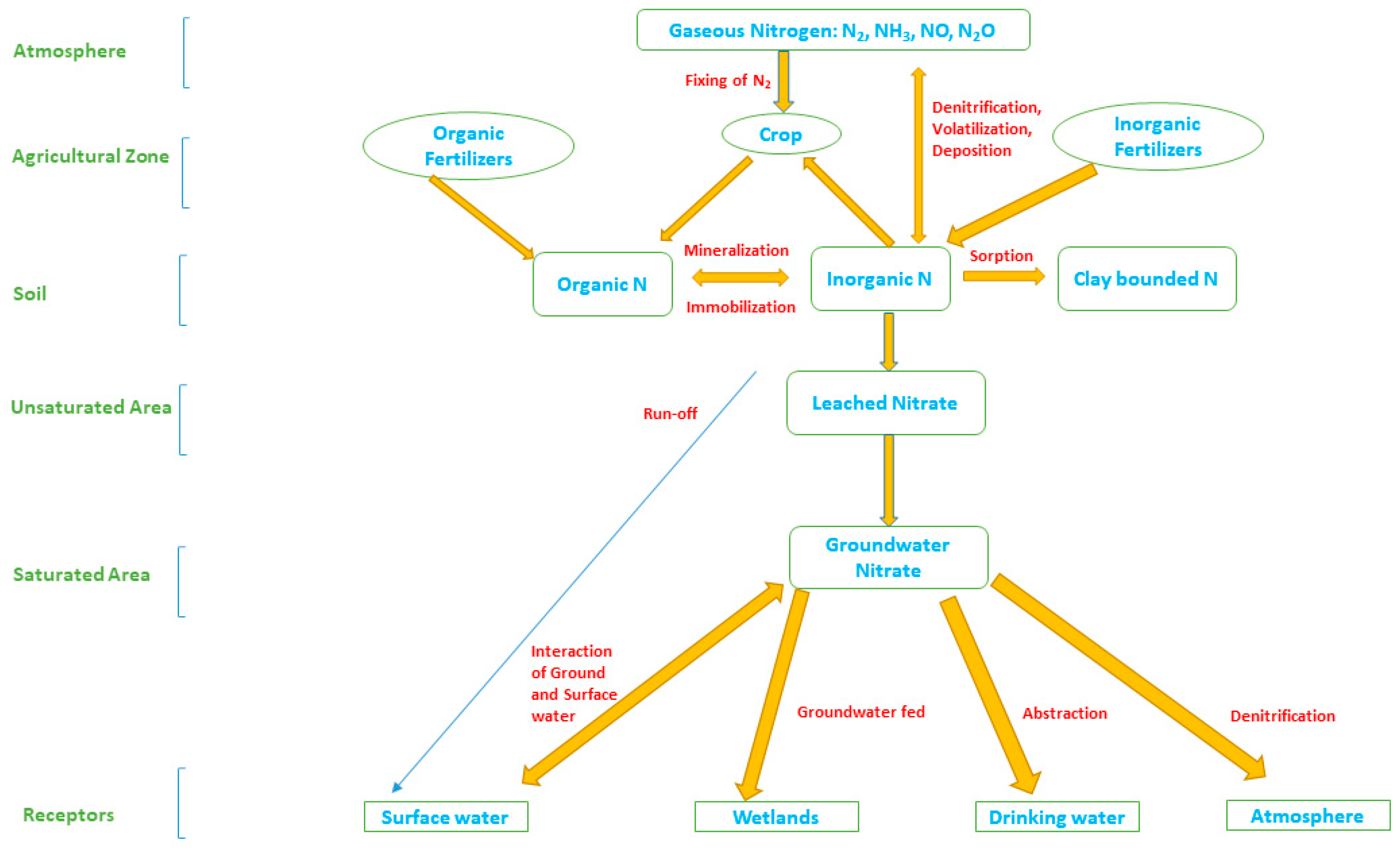

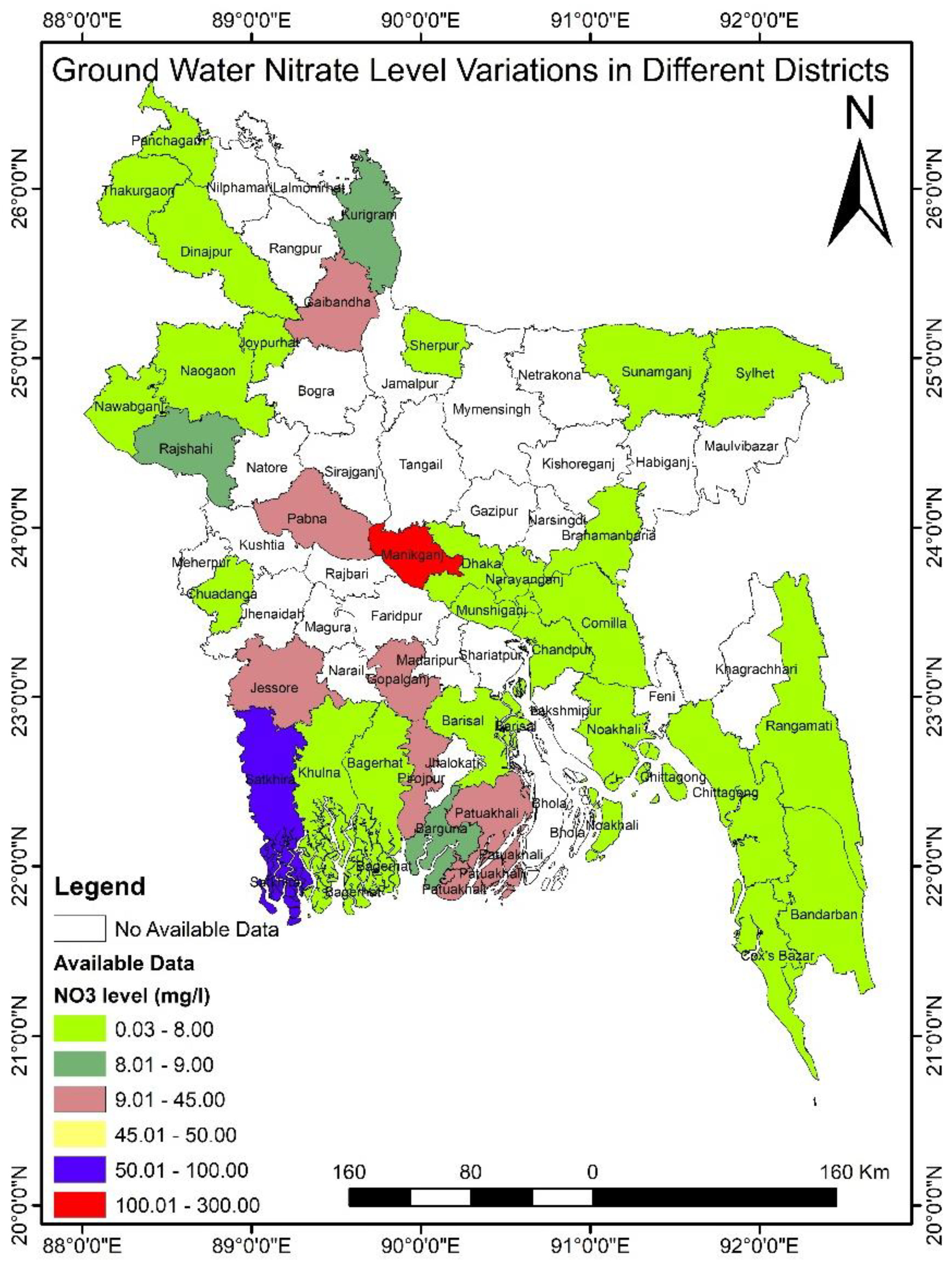
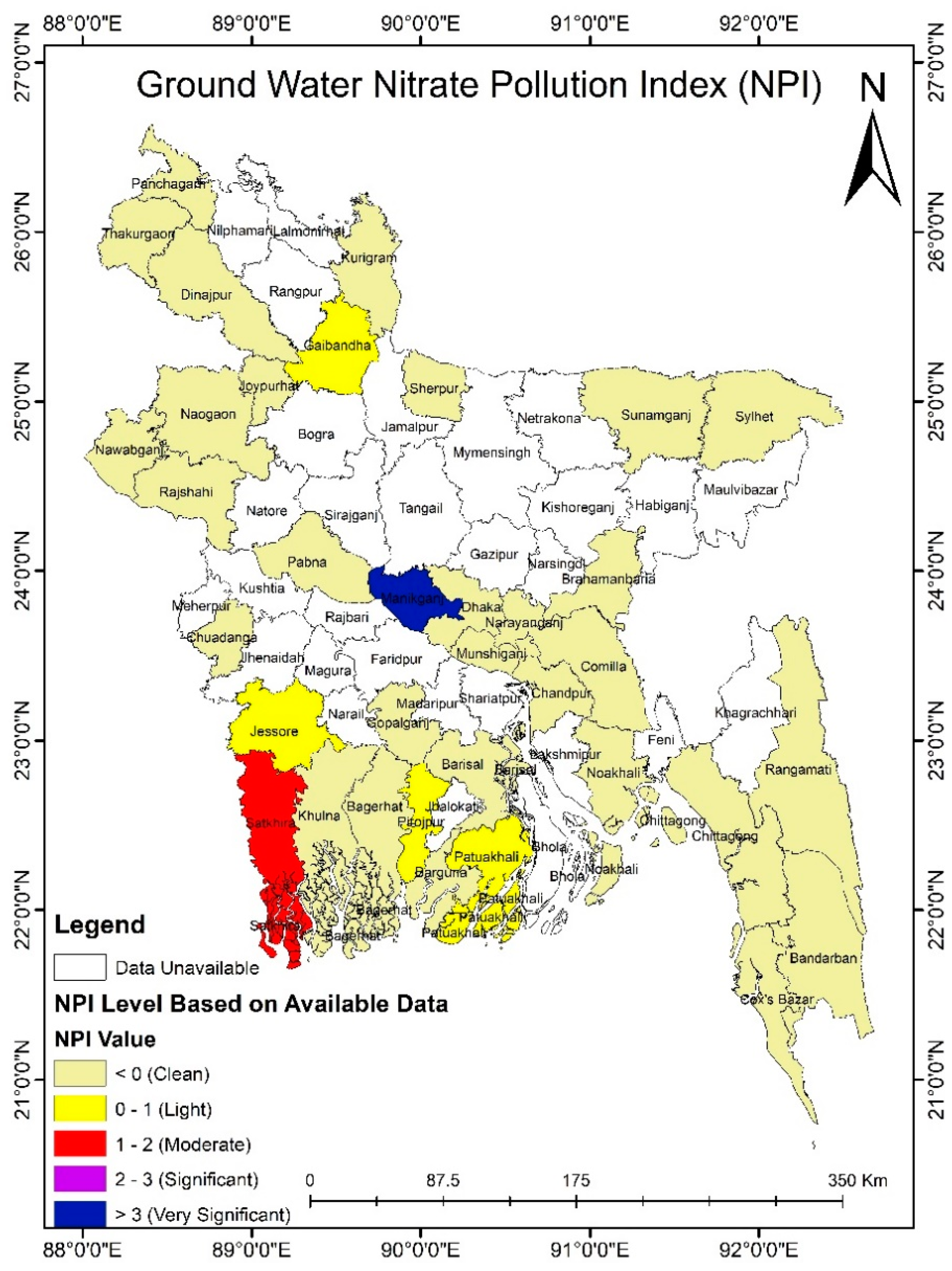
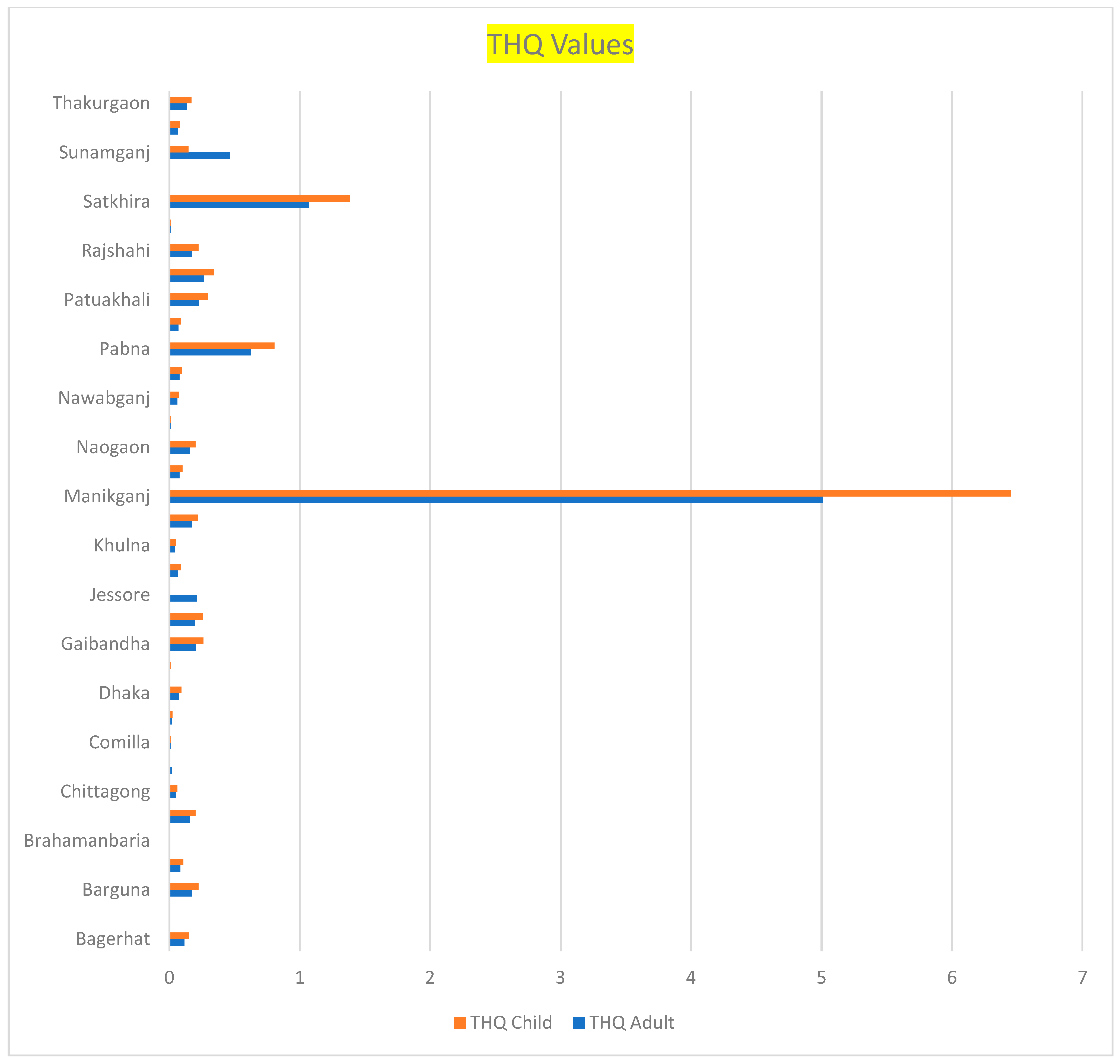

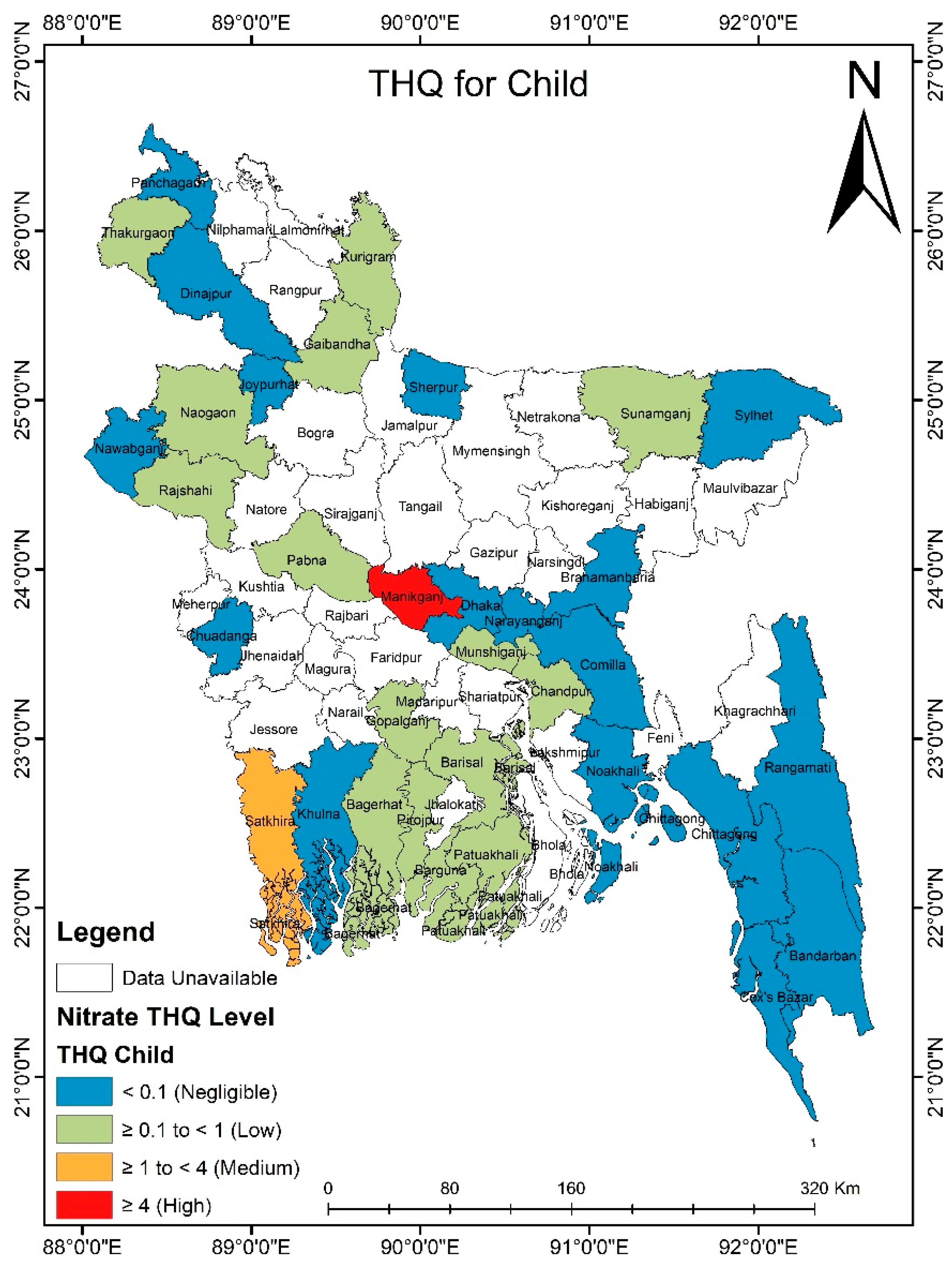
| NPI Value | Pollution Level |
|---|---|
| <0.0 | Clean |
| 0.1–1.0 | Light |
| 1.1–2.0 | Moderate |
| 2.1–3.0 | Significant |
| >3.0 | Very significant |
| THQ Value | Chronic Risk |
|---|---|
| <0.1 | Negligible |
| >0.1 < 1.0 | Low |
| ≥1.0 < 4.0 | Medium |
| ≥4.0 | High |
| General Sources | Specific Sources |
|---|---|
| Natural sources |
|
| Pilling of waste load |
|
| Agricultural practice |
|
| S.N | Districts | NO3 Level (mg/L) | References |
|---|---|---|---|
| 1. | Bagerhat | 5.87 | [53] |
| 2. | Bandarban | 0.107 | [54] |
| 3. | Barguna | 8.8 | [11] |
| 4. | Barisal | 4.23 | [55] |
| 5. | Brahamanbaria | 0.25 | [56] |
| 6. | Chandpur | 7.9 | [57] |
| 7. | Chittagong | 2.47 | [54] |
| 8. | Chuadanga | 0.03 | [58] |
| 9. | Comilla | 0.55 | [59] |
| 10. | Cox’s Bazar | 0.925 | [54] |
| 11. | Dhaka | 3.6 | [12] |
| 12. | Dinajpur | 0.35 | [60] |
| 13. | Gaibandha | 10.27 | [61] |
| 14. | Gopalganj | 9.96 | [62] |
| 15. | Jessore | 10.62 | [13] |
| 16. | Joypurhat | 3.45 | [63] |
| 17. | Khulna | 2.13 | [64] |
| 18. | Kurigram | 8.69 | [65] |
| 19. | Manikganj | 253.18 | [8] |
| 20. | Munshiganj | 3.93 | [10] |
| 21. | Naogaon | 7.9 | [66] |
| 22. | Narayanganj | 0.53 | [12] |
| 23. | Nawabganj | 3.02 | [67] |
| 24. | Noakhali | 3.9 | [54] |
| 25. | Pabna | 31.69 | [14] |
| 26. | Panchagarh | 3.45 | [63] |
| 27. | Patuakhali | 11.57 | [68] |
| 28. | Pirojpur | 13.5 | [69] |
| 29. | Rajshahi | 8.75 | [70] |
| 30. | Rangamati | 0.534 | [54] |
| 31. | Satkhira | 54.44 | [71] |
| 32. | Sherpur | 0.19 | [61] |
| 33. | Sunamganj | 5.19 | [72] |
| 34. | Sylhet | 3.18 | [54] |
| 35. | Thakurgaon | 6.66 | [73] |
Disclaimer/Publisher’s Note: The statements, opinions and data contained in all publications are solely those of the individual author(s) and contributor(s) and not of MDPI and/or the editor(s). MDPI and/or the editor(s) disclaim responsibility for any injury to people or property resulting from any ideas, methods, instructions or products referred to in the content. |
© 2023 by the authors. Licensee MDPI, Basel, Switzerland. This article is an open access article distributed under the terms and conditions of the Creative Commons Attribution (CC BY) license (https://creativecommons.org/licenses/by/4.0/).
Share and Cite
Muhib, M.I.; Ali, M.M.; Tareq, S.M.; Rahman, M.M. Nitrate Pollution in the Groundwater of Bangladesh: An Emerging Threat. Sustainability 2023, 15, 8188. https://doi.org/10.3390/su15108188
Muhib MI, Ali MM, Tareq SM, Rahman MM. Nitrate Pollution in the Groundwater of Bangladesh: An Emerging Threat. Sustainability. 2023; 15(10):8188. https://doi.org/10.3390/su15108188
Chicago/Turabian StyleMuhib, Md. Iftakharul, Mir Mohammad Ali, Shafi M. Tareq, and Md. Mostafizur Rahman. 2023. "Nitrate Pollution in the Groundwater of Bangladesh: An Emerging Threat" Sustainability 15, no. 10: 8188. https://doi.org/10.3390/su15108188
APA StyleMuhib, M. I., Ali, M. M., Tareq, S. M., & Rahman, M. M. (2023). Nitrate Pollution in the Groundwater of Bangladesh: An Emerging Threat. Sustainability, 15(10), 8188. https://doi.org/10.3390/su15108188








